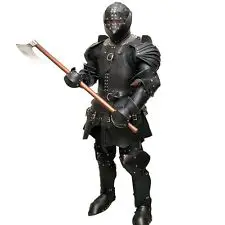Leather Armor
During the middle ages, leather armor, particularly in the early Middle Ages, was one of the most popular types of armor to be used. In the later stages of the Middle Ages, leather became less popular but there was always a place for it in the soldier’s battle gear. The reason leather armor was so popular was because it was cheap and fairly easy to find. Another reason why leather armor was popular was because it did not take as much skill to make as ring mail or plate mail. A soldier could make his own repairs if necessary.

Leather armor was typically used by the lower classes although it was also used by some nobility who couldn’t afford more expensive armor. Leather armor became less popular as ring mail and plate mail became cheaper but a typical soldier always wore some leather armor even if it was just around his legs or under his ring mail. It was also used as the base to make other armor such as brigandine armor.

Types of Leather Armor
Leather was used to make different types of armor. The earliest method was to simply use thick leather to make a vest or a jacket. Later on, metal plates were attached to reinforce the leather. This armor provided protection from cutting actions but it did not provide a lot of protection from punctures. Leather armor was rarely made into a full suit of armor.

Cuir bouilli
Cuir bouilli (or boiled leather) is provided more protection than simple plain leather. The leather would be boiled in a vat of oil or molten wax. Once the leather has boiled for a while, it would be removed from the pot and formed into the shape the maker wanted, such as a chest plate. Once this was done, the leather would be left to harden and dry. The resulting leather was much lighter than metal and offered good protection from cuts and punctures.
Boiled leather would be smaller in size once it was boiled but it would be thicker and tougher. Boiled leather was not only used for chest plates (or breastplates), but also for gauntlets (gloves) and for pads, which were used to protect the knees and elbows.
One problem with cuir bouilli and other types of leather armor is that is doesn’t last very long and does not do well in bad weather. The armor needed to be keep dry and needed to be oiled regularly. If the soldier did not do this, then the armor would begin to crack and rot.
On the other hand, it did not take a lot of skill to repair the armor and a soldier could typically make the repairs himself. He didn’t need to find a skilled armorer the way people who wore plate mail had to.

Leather as a Base
At times, leather was not used as armor on its own but was used in combination with other armor to provide more protection. Even if a soldier wore ring mail or plate mail, leather was still used to enhance the soldier’s protection. Often, a soldier would wear leather armor around his legs so that he would have protection but still be fairly mobile.
Brigandine: Europeans first learned about Brigandine armor from the Mongols who invaded Europe in the 13th century. Brigandine is another form of leather armor but it had small metal plates attached to it. The plates were either attached to the outside of the leather or were placed in between two layers of leather. The brigandine quickly became a popular piece of armor with both common soldiers and the nobility.
These plates were different sizes and some examples have shown larger plates covering the more vulnerable areas of a soldier’s body, such as the lungs and heart area. The plates were riveted into place and these rivets were often decorated with gold leaf or with a design on each rivet.
The brigandine could be repaired by its owner without needed the major skills of an armorer.
Ring Mail: The earliest ring mail actually started out as leather armor with metal rings attached to the outside of it. Later on, this evolved into armor made completely of linked rings.
Leather armor has been used in a variety of forms throughout the Middle Ages. Even after other forms of armor became more popular, leather armor still had its place, either as an under layer, an over layer or covering parts of the body such as the legs, in ensuring that the soldier was protected in battle.




